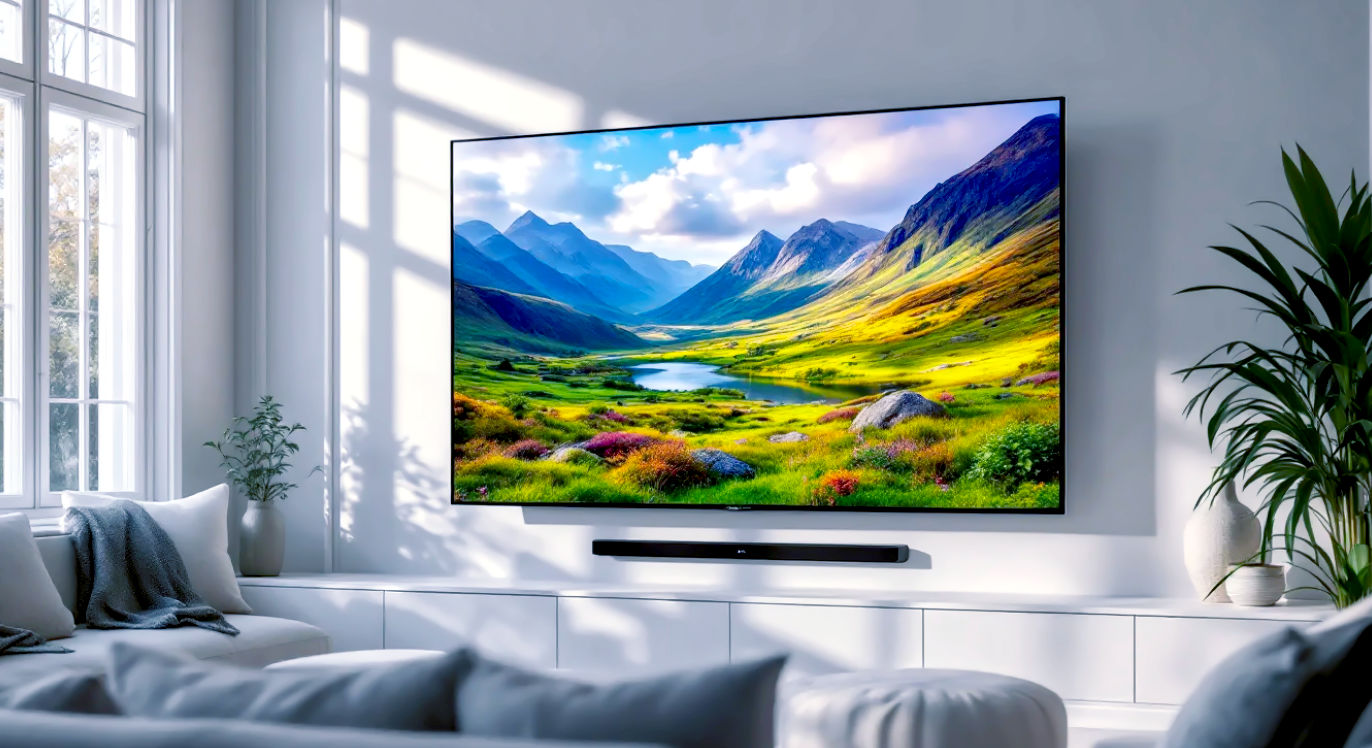The UK Guide to QLED TVs: Top Models & Revolutionary Features Explained
Your complete guide to QLED TVs. We explain the tech, compare it to OLED, and review the top models in the UK for movies, gaming, and bright rooms.

This post may contain affiliate links. If you make a purchase through these links, we may earn a commission at no additional cost to you.
Picture this: it’s a bright Saturday afternoon. The sun’s streaming through the window, you’ve just made a cuppa, and you’re settling down to watch that new dark, moody thriller everyone’s been talking about. But instead of getting lost in the drama, you’re stuck staring at your own reflection. The shadowy scenes are a murky mess, and you can’t tell the hero from a bit of furniture. If that sounds familiar, you’ve experienced the exact problem that QLED TVs were born to solve.
For years, we’ve been told that to get the best picture, you need an OLED TV. And while OLEDs are fantastic, they’re not the only players in the game. QLED technology, spearheaded by Samsung, has stormed onto the scene, promising brighter, bolder, and more vibrant images that don’t shy away from a bit of daylight.
But what exactly is QLED? Is it just another confusing acronym in the world of telly tech? And is it the right choice for your living room?
Don’t worry. We’re here to cut through the jargon. This is your definitive guide to everything QLED. We’ll explain how it works in simple terms, pit it against its main rival, OLED, and take you through the top models you can buy right now in the UK. By the end, you’ll know for sure whether a QLED TV is the missing piece for your perfect home entertainment setup.
What on Earth is a QLED TV?
Let’s get the biggest misconception out of the way first. Despite the similar-sounding name, QLED is not the same as OLED.
At its heart, a QLED TV is an advanced type of LCD TV. It uses many of the same core components as the LED telly that might have been sitting in your lounge for the last decade. It has a backlight made of LEDs (Light Emitting Diodes) to create light, and an LCD (Liquid Crystal Display) panel to block that light to form a picture.
The secret ingredient, the magic dust that turns a standard LED TV into a QLED TV, is a tiny, remarkable technology called Quantum Dots.
The Magic of Quantum Dots: A Simple Explanation
Imagine you have a set of microscopic crystals, so small that you could fit millions of them on the head of a pin. These are Quantum Dots. The amazing thing about them is that when you shine a light on them, they glow with an incredibly pure and precise colour.
What colour they glow depends entirely on their size. The smallest dots produce a pure blue light, slightly larger ones create a perfect green, and the largest ones emit a flawless red.
Think of it like this: a normal TV backlight is like a standard lightbulb – it produces a messy, yellowish-white light. To create colours, the TV has to use colour filters to strip out everything it doesn’t need, which is inefficient and wastes a lot of light.
A QLED TV does things differently. It starts with a very efficient blue LED backlight. It then places a sheet coated with these red and green Quantum Dots in front of that light. When the blue light hits the dots, they do their magic, converting some of it into pure red and pure green.
This combination of pure red, green, and blue light gives the TV a perfect palette to work with. It’s like giving an artist exceptionally high-quality paints instead of a muddy, watered-down set. The result? Colours that are brighter, more accurate, and far more vibrant than what a traditional LCD TV can manage.
The Technical Lowdown: How It All Fits Together
For those who like a bit more detail, here’s a quick look under the bonnet of a modern QLED TV:
- The Backlight: This is where the light comes from. In older models, this was a simple row of LEDs. But modern, high-end QLEDs use Mini LED technology. Instead of a few hundred LEDs, they have thousands of tiny ones. This allows the TV to have incredibly precise control over which parts of the screen are bright and which are dark. This is the key to achieving deep blacks and dazzling highlights. We’ll call this local dimming.
- The Quantum Dot Film: This is the hero of the story. A thin layer packed with those red and green Quantum Dots sits in front of the backlight, creating the pure white light needed for the screen.
- The LCD Panel: This is the final gatekeeper. It’s a grid of millions of tiny pixels that can twist open or closed to let the light through or block it. By controlling these pixels and the backlight behind them, the TV creates the final image you see.
So, in short: QLED = An LED TV + A Quantum Dot Filter. It’s this clever addition that unlocks a whole new level of performance.
The Big Showdown: QLED vs. OLED
You can’t talk about QLED without mentioning its arch-rival, OLED. For years, this has been the ultimate TV tech face-off, like Blur vs. Oasis for your living room. They take fundamentally different approaches to creating a picture, each with its own distinct strengths and weaknesses.
OLED (Organic Light Emitting Diode) TVs work completely differently. Each individual pixel on an OLED screen creates its own light. There’s no backlight at all. If a pixel needs to be black, it just switches off. Completely.
This leads to some key differences. Let’s break them down.
Brightness: The QLED Superpower
Winner: QLED
This is QLED’s home turf. Because they use a powerful, separate backlight, QLED TVs can get incredibly bright – much brighter than any OLED TV. Top-end models can hit peaks of over 2,000 nits (a measure of brightness), whereas the best OLEDs currently top out around 1,500 nits.
Why does this matter? Two reasons.
Firstly, if you have a bright room with lots of natural light, a QLED TV has the raw power to punch through the glare and deliver a vibrant, watchable picture. Secondly, it’s a massive advantage for HDR (High Dynamic Range) content. HDR is all about showing the brightest highlights and the darkest shadows in the same scene. Think of the glint of the sun on a car, a bright explosion, or the sparkle of stars. A QLED’s high brightness makes these moments look incredibly realistic and impactful.
Black Levels and Contrast: The OLED Ace Card
Winner: OLED
This is where OLED’s self-lighting pixels come into play. When an OLED pixel needs to be black, it turns off completely, producing no light whatsoever. This is what we call “perfect” or “infinite” contrast. The difference between the brightest white and the darkest black is, literally, infinite.
A QLED TV, even a top-end Mini LED one, can’t quite match this. Because it relies on a backlight, a tiny amount of light can always bleed through the LCD panel, even when it’s trying to show black. Modern local dimming has made this effect, known as “blooming” or the “halo effect,” much less noticeable, but it can still be seen sometimes, especially when a very bright object is next to a very dark background (like subtitles on a black bar).
For movie lovers who watch in a dark room, OLED’s perfect blacks create a picture with incredible depth and atmosphere.
Colour: A Battle of Vibrancy
Winner: It’s Complicated (but QLED has an edge)
Both technologies produce fantastic, lifelike colours. However, they excel in different ways. Thanks to Quantum Dots, QLEDs are masters of colour volume. This means they can reproduce a wider range of colours at very high brightness levels. An OLED might struggle to show a deep, rich red when it’s also trying to be incredibly bright, whereas a QLED can do it with ease. This makes HDR content look incredibly rich and saturated on a QLED.
OLEDs, on the other hand, can look slightly more natural in darker scenes because of their superior contrast. It’s a subtle difference, and both technologies offer some of the best colour you’ll see on a screen.
Viewing Angles: A Clear Win for OLED
Winner: OLED
If you often have family or friends spread out across the sofa, this is an important one. With an OLED TV, the picture looks virtually identical no matter where you sit. The colours and contrast remain perfect even from an extreme side angle.
QLED TVs, being based on LCD technology, have weaker viewing angles. As you move off-centre, the colours can start to look a little washed out and the black levels can appear greyer. Manufacturers have added special layers to their screens to improve this, and modern QLEDs are much better than they used to be, but OLED still has a clear advantage here.
Screen Burn-in: The QLED Safety Net
Winner: QLED
Screen burn-in, or permanent image retention, is when a static image (like a news channel logo or a game’s health bar) is displayed for so long that it leaves a faint, permanent ghost on the screen.
Because OLED pixels are organic, they degrade over time. If you display the same static image for hundreds of hours, the pixels used for that image can wear out faster than the others, leading to burn-in. While modern OLEDs have lots of clever features to prevent this, and it’s very rare with normal viewing, it remains a small but genuine risk.
Quantum Dots are inorganic. They don’t degrade in the same way, making QLED TVs virtually immune to burn-in. This provides fantastic peace of mind, especially if you’re a keen gamer or watch a lot of news channels.
Price: The People’s Champion
Winner: QLED
Generally speaking, QLED TVs offer better value for money, especially as you go up in screen size. While flagship models from both camps are expensive, you can get a very good mid-range 65-inch QLED for significantly less than a comparable OLED. If you’re looking for the biggest screen for your budget, QLED is almost always the way to go.
QLED vs. OLED: Quick Summary
| Feature | QLED TV | OLED TV | The Winner Is… |
|---|---|---|---|
| Brightness | Exceptionally bright, great for HDR and sunny rooms. | Good, but can’t match QLED’s peak brightness. | QLED |
| Black Levels | Very deep blacks with Mini LED, but slight blooming possible. | Perfect, absolute blacks as pixels switch off. | OLED |
| Contrast | Excellent, especially on flagship models. | Infinite. Unbeatable for depth and cinematic feel. | OLED |
| Colour | Incredible colour volume, especially at high brightness. | Stunningly accurate and natural colours. | Draw |
| Viewing Angles | Good on high-end models, but can fade off-centre. | Perfect from almost any angle. | OLED |
| Burn-in Risk | Virtually zero. A huge selling point. | A very small but real risk with static images. | QLED |
| Gaming | Top-tier features, very low input lag, no burn-in risk. | Fantastic response times, but burn-in is a concern for some. | QLED |
| Price | Generally more affordable, especially for larger sizes. | Tends to be more expensive. | QLED |
Key QLED Features and Tech Explained
When you start shopping for a QLED TV, you’ll be hit with a barrage of technical terms. Let’s quickly decode the most important ones so you know what you’re looking for.
Neo QLED and Mini LED: The Backlight Revolution
This is one of the biggest advancements in recent years. As we mentioned, traditional LED TVs used a handful of large LEDs as a backlight. Mini LED technology, which Samsung brands as Neo QLED, shrinks these LEDs down to about 1/40th of their original size.
This means you can pack thousands of them behind the screen, grouped into hundreds or even thousands of individual local dimming zones. The TV can then control the brightness of each zone with incredible precision. It can make one zone brilliantly bright for a firework explosion while keeping the zone right next to it completely dark for the night sky.
This is what allows modern QLEDs to get so close to OLED-like black levels while retaining their massive brightness advantage. If you want the best QLED performance, you want a Mini LED model.
For the Gamers: VRR, 120Hz, and the Gaming Hub
QLED TVs have become a top choice for gamers, and for good reason. Top models are packed with features designed for the latest consoles like the PlayStation 5 and Xbox Series X.
- 120Hz (or even 144Hz) Refresh Rate: This means the screen can update the picture 120 times per second, double the standard 60. This makes motion incredibly smooth and responsive, which is a huge advantage in fast-paced games.
- VRR (Variable Refresh Rate): This technology, which includes AMD FreeSync and Nvidia G-Sync, allows the TV to sync its refresh rate with the frame rate of the console. This eliminates ugly screen tearing and stuttering, resulting in a perfectly smooth gaming experience.
- ALLM (Auto Low Latency Mode): The TV automatically switches to its super-fast “Game Mode” when it detects you’re playing a game, ensuring the lowest possible input lag (the delay between you pressing a button and seeing the result on screen).
- Samsung Gaming Hub: This is a dedicated interface on Samsung TVs that brings together all your cloud gaming services (like Xbox Game Pass and Nvidia GeForce Now) and console games in one easy-to-use place.
Combine these features with the bright, vibrant picture and zero burn-in risk, and you have a TV that’s practically built for gaming.
Smart TV Experience: Tizen and Google TV
A modern TV is only as good as its smart platform. Samsung, the biggest QLED player, uses its own Tizen operating system. It’s a fast, clean, and comprehensive system with all the major UK streaming apps you’d expect: BBC iPlayer, ITVX, Netflix, Disney+, Prime Video, and Now.
Other brands that make QLED TVs, like TCL and Hisense, often use Google TV (which is built on top of Android TV). This is also an excellent platform, known for its content recommendations and integration with the Google ecosystem. Both are great choices, so it often comes down to personal preference.
Sound Technology: OTS and Q-Symphony
TV manufacturers have also made big strides in built-in audio. Samsung’s Object Tracking Sound (OTS) uses multiple speakers placed around the TV to make the sound feel like it’s coming from the right place on the screen. If a car drives from left to right, the sound will follow it.
Q-Symphony is another clever trick. If you buy a compatible Samsung soundbar, the TV’s own speakers will work with the soundbar instead of switching off, creating a bigger, more immersive soundstage.
Who Makes the Best QLED TVs? A Look at the Brands
While Samsung pioneered the technology and remains the market leader, they’re not the only name in the game anymore.
Samsung: The Kings of QLED
As the originators, Samsung offers the widest and most advanced range of QLED TVs, from mid-range models to ridiculously high-end 8K flagships.
- Flagship 4K (QN90/QN95 Series): These are the all-singing, all-dancing Neo QLED (Mini LED) models. They offer the best brightness, the most advanced local dimming, and all the top gaming features. The QN95 series usually includes the One Connect Box, a clever external box that houses all your inputs, allowing for a cleaner, single-cable installation.
- Mid-Range (Q80/Q70 Series): These models offer a great balance of performance and price. You might lose the Mini LED backlight (stepping down to a more traditional full-array local dimming system) and some of the peak brightness, but you still get fantastic colours and a great set of gaming features.
- 8K Models (QN800/QN900 Series): These are Samsung’s top-of-the-line TVs. While native 8K content is still very rare, these TVs use powerful AI processors to upscale 4K content, making it look sharper and more detailed. They also represent the pinnacle of Samsung’s brightness and processing technology.
TCL & Hisense: The Value Challengers
These Chinese brands have made a huge splash in the UK market by offering QLED and Mini LED technology at incredibly competitive prices.
- TCL: Often seen as the number two brand in the world for TV sales, TCL’s Mini LED QLEDs regularly win awards for offering performance that comes shockingly close to the big names, but for hundreds of pounds less. They typically use the Google TV platform.
- Hisense: Another brand offering fantastic value. Hisense also produces high-performance Mini LED QLEDs and has its own simple-to-use VIDAA smart TV platform. They are a great option if you want to maximise screen size for your money.
The Future is Bright: QD-OLED and Beyond
The battle between QLED and OLED has led to an incredible innovation: QD-OLED. This is a hybrid technology, first commercialised by Samsung Display, that aims to combine the best of both worlds.
A QD-OLED screen uses a layer of blue OLED material to generate light (no backlight needed). It then uses Quantum Dots to convert this blue light into pure red and green.
The result? You get the perfect black levels, pixel-level contrast, and flawless viewing angles of OLED, combined with the superior colour purity and higher brightness potential of Q-Dot technology.
QD-OLED TVs (sold by Samsung and Sony) are now considered by many experts to be the pinnacle of picture quality, but they come with a premium price tag. For now, they represent the high-end future, while Mini LED QLED continues to offer the best performance for most people in most rooms.
So, Should You Buy a QLED TV?
After all that, we come to the big question. A QLED TV is an absolutely fantastic choice for a huge number of people. It’s likely the right TV for you if:
- You have a bright living room. This is QLED’s biggest strength. Its sheer brightness can cut through daylight and reflections like no other technology, delivering a punchy, vibrant image when an OLED might struggle.
- You’re a serious gamer. The combination of a bright, fast, and responsive screen with zero risk of burn-in makes a high-end QLED one of the best possible choices for gaming.
- You want the most impactful HDR experience. To get the full “wow” factor from HDR movies and games, you need bright highlights. QLED delivers these in spades.
- You want the biggest screen for your money. QLED technology is generally more affordable than OLED, especially at sizes of 65 inches and above.
QLED is no longer just an alternative to OLED; it’s a phenomenal, mature technology in its own right. It has brought top-tier picture quality to millions, banishing reflective screens and murky images from our living rooms. So next time you’re squinting at your screen on a sunny afternoon, you’ll know exactly what the solution is.
Further Reading
For those who want to dive even deeper into TV technology and read detailed professional reviews, we recommend these excellent resources:
- What Hi-Fi?: A highly respected UK-based publication for home entertainment reviews.
- TechRadar: Offers great explanations, reviews, and news on the latest TV tech.
- RTINGS.com: Known for their incredibly in-depth, lab-based TV testing and comparisons.
- Samsung Display: The official source for information on the underlying Quantum Dot and QD-OLED technologies.






